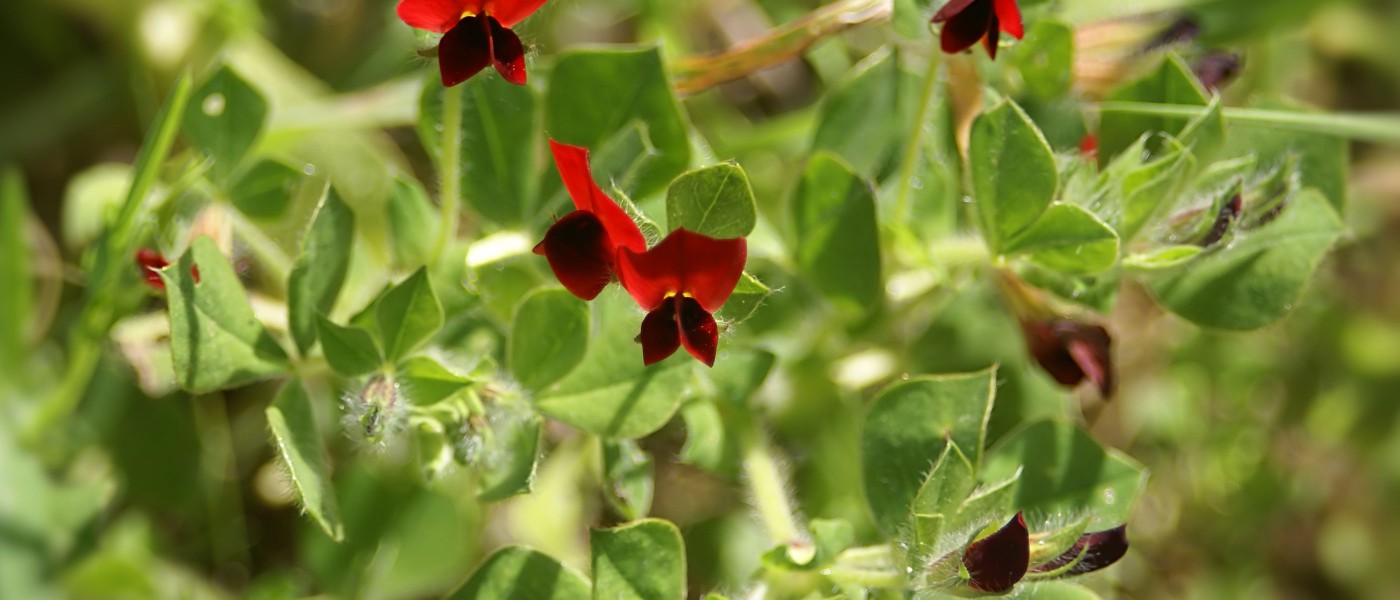The Asparagus Pea
I live on the Caribbean island of Vieques, seven miles off the coast of Puerto Rico. This year I am putting in a 75- by 50-foot vegetable garden and am wildly excited by the project. The ever-balmy weather prevents me from cultivating some of my northern cool-weather favorites—Japanese mustard, radishes, and sweet peas. However, it more than compensates by letting me grow some unusual tropical and Mediterranean vegetables, such as Malabar spinach (Basella rubra), sweet-corn root (Maranta species), and the wonderfully frolicsome asparagus pea.
The asparagus pea is one of the prettiest vegetables on the planet. Its Latin name, Tetragonolobus purpurea, is even prettier. The genus epithet, meaning "four-lobed," describes the four little frills or wings that line the plant's edible seedpods and give them a look of foursquare frivolity. The species name is meant to describe the purple color of the flowers—although, in fact, the flowers are deep red.
Why does the word "asparagus" appear in the common name? It may be because of the seedpods' delicate asparaguslike flavor. Or perhaps it's because some epicures say that asparagus peas are best treated like asparagus spears—boiled or steamed ever so briefly, drained swiftly, anointed with butter, and ferried quickly to the table for immediate consumption. Another common name for T. purpurea is the winged pea, but this seems a little too understated to me. Something like the "Pegasus pea" would be more appropriate, I think.
Asparagus pea is a scrambling, herbaceous annual legume endemic to the Mediterranean region of southern Europe, where it is a common spring-blooming wildflower in field and scrub. There are records of its cultivation in Sicily from the mid-16th century. Growing around 6 inches tall and 24 inches wide, the plant has small trifoliate leaves, and its deep crimson flowers are borne in pairs.
The winged pods that develop after flower pollination grow up to 3 1/2 inches long. The pods may be boiled, sautéed, steamed, dipped in tempura batter and deep-fried, or pickled. The mature peas have been employed as a coffee substitute. The comely flowers can be applied as edible garnishes to salads, cheeses, and pâtés.
Asparagus pea couldn't be easier to cultivate, needing just average moisture, full sun, and standard soil to succeed. However, it does require a long growing season to flower and fruit properly. Relishing high heat in the summertime, the plant is perfect for the deep southern or southwestern potager. Seeds can be sown in situ in early to mid-June when the soil is thoroughly warmed and nighttime temperatures remain constant. (Asparagus pea seeds are available from Thompson & Morgan; 800-274-7333.)
Northern gardeners will have to start their plants indoors in early spring. They can solve the problem of early frost by cultivating asparagus peas in containers and moving them inside to a greenhouse or sunny bay window to complete maturation.
Asparagus pea plants need a little extra physical support to keep them tidy and off the soil. This helps avoid slug damage, facilitates air circulation, and makes harvesting a little easier on the back. Use inverted twigs to create a rustic support system, or weave a crude wattle fencing from fresh willow stems.
Pods need to be picked when they are just one to two inches long (or a day or two after the flowers fade). Otherwise, they become too fibrous to be eaten. This means you'll need to make a daily foray into the vegetable garden to harvest them. Bring a stool and sit whilst picking—your sacroiliac will thank you. This is a great chore to do with children, who'll have lots of fun searching through the foliage for the unusual-shaped pea pods. They're also a lot closer to the ground than we adults!
Store the produce in zip-seal bags in the lower portion of the refrigerator until there is enough to make an entrée or side dish. Inevitably, some pods will go overlooked on the plants and mature to the point of becoming stringy and papery. Use the mature, small dry peas in any of your favorite legume recipes.
Thai Asparagus Pea Salad (Yam Tua Poo)
- 1 cup asparagus peas, topped and tailed, steamed till just tender, and plunged briefly in ice water
- 1 cup shrimp, boiled and shelled
- 1 cup extra-firm tofu, pressed to extrude excess water and cubed
- 1 to 2 tablespoons nam prik pow (Thai roasted chili paste)
- Juice of 1 lime
- Palm sugar or light brown sugar
- 1 cup coconut cream
- 1/4 cup sliced garlic
- 1/4 cup sliced shallots
- 1/4 cup dried red chili peppers, sliced thinly lengthwise, with seeds removed
- Peanut or vegetable oil
- 1/4 cup crushed, toasted peanuts
- 1/4 cup dried, grated coconut, lightly toasted
Gently mix the asparagus peas, seafood, and tofu. For the dressing, mash the nam prik pow with a little lime juice and 1/2 teaspoon sugar until it dissolves. Add 3/4 of the coconut cream. Adjust flavor with sugar, salt, and remaining lime juice to taste. Fry the garlic, shallots, and chilis until crispy but not burned. When cooled, add the fried vegetables to the asparagus pea mixture along with the dressing. Mix gently. Add more coconut cream, salt, sugar, or lime juice to taste. Place in a serving dish and sprinkle the peanuts and coconut on top. Serves 2 to 4.


